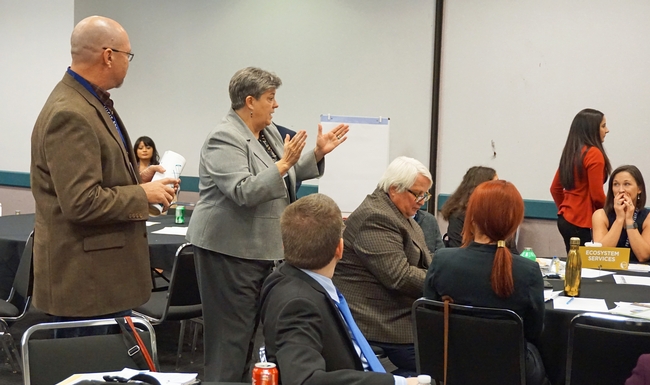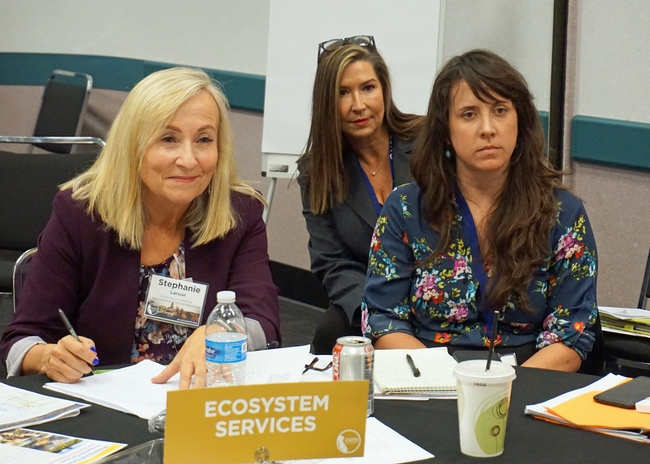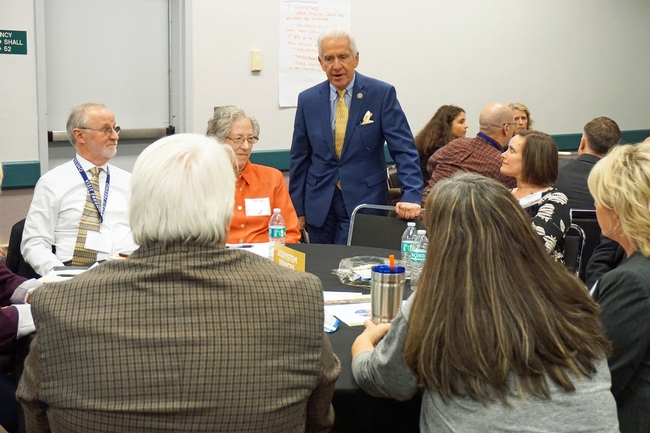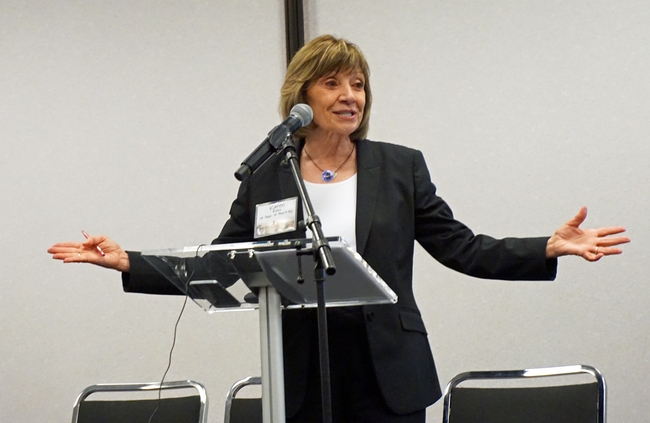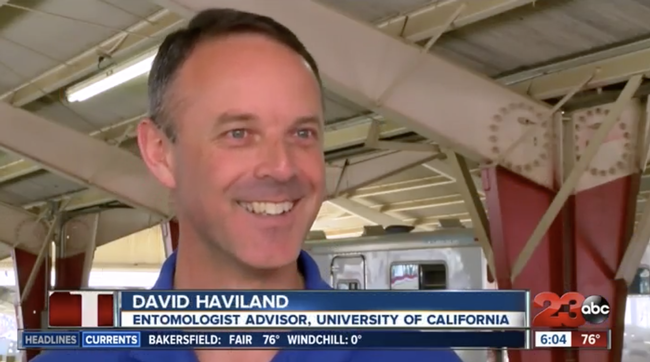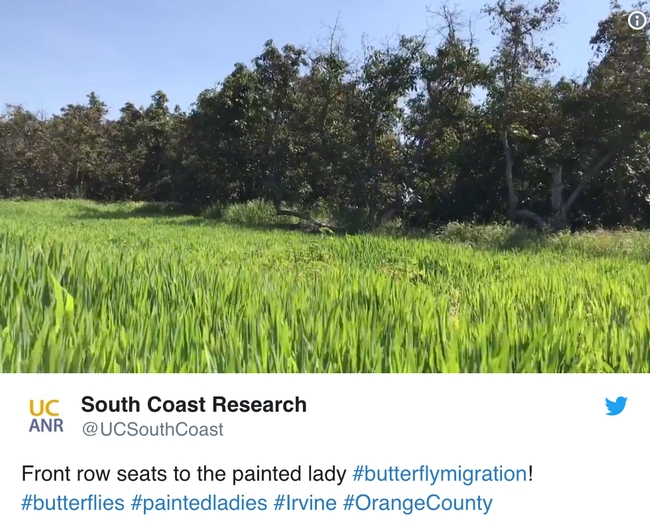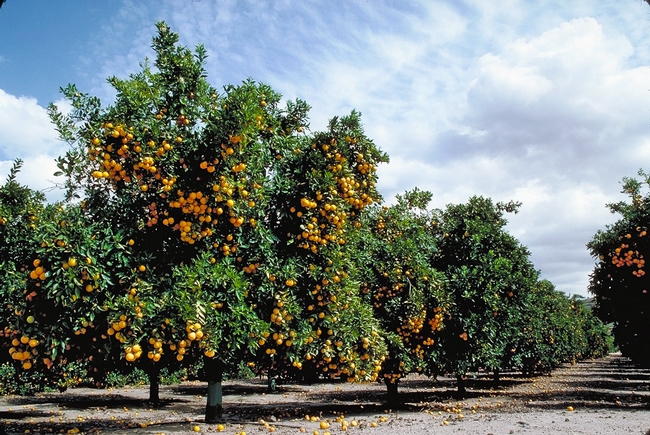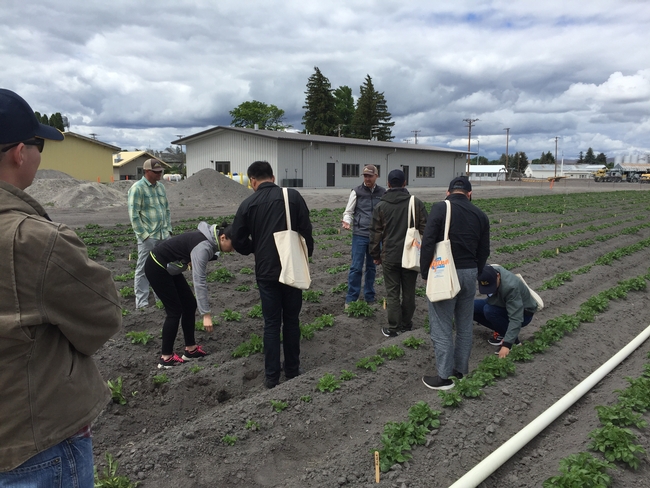Posts Tagged: Glenda Humiston
To protect California ecosystem services, they must be valued
The ecosystem services of landscapes in California are essential to the state's future, but many people take them for granted.
In addition to direct economic outputs, working landscapes – farms, rangelands, forests and fisheries, to name a few – sequester carbon, capture water, support wildlife, offer picturesque views and make space for hiking, skiing, boating and other recreational activities.
“We need to put a value to ecosystem services, from an economic standpoint, that incentivizes people who own and manage these landscapes so they can continue to manage them for everyone's benefit,” said Stephanie Larson, UC Cooperative Extension rangeland advisor in Sonoma County.
When ecosystem services have been monetized, proper compensation can be calculated, ensuring benefits like clean water, fresh air and a livable climate are protected for future generations.
In November, UC Agriculture and Natural Resources released a report at the California Economic Summit in Fresno on the value of California's working landscapes. The report determined the state's working landscapes generate $333 billion in annual sales and 1.5 million jobs. That number does not include ecosystem services.
“The value of ecosystem services is probably higher than the $333 billion direct economic contribution of working landscapes outlined in the report,” said Glenda Humiston, University of California vice president for agriculture and natural resources. Humiston is chair of the economic summit's working landscape task force. “The problem is, when we don't have that quantified, it's hard to make investments to make sure those ecosystem services are maintained.”
Humiston said that, in time, systems can be developed for the public to support the ecosystem services they enjoy.
“You might have a small surcharge on binoculars,” she said. “That money could be used to protect bird habitat so birders can go somewhere to see birds. Water districts might assess a surcharge on your water bill to pay for the forested watersheds where they are getting your water. There are many different mechanisms to do this. We're trying to figure out what would be the best mechanism.”
During the summit, a team of researchers, policymakers and industry professionals launched a new phase of work to calculate with scientific accuracy the value of ecosystem services. Larson is a member of the leadership team, along with executive director of the Central Valley Partnership Dan O'Connell and Sequoia Riverlands Trust director of pubic planning and policy Adam Livingston.
The team is working with partners to secure funding and technical support to integrate data sets already available from the Council of Governments' Rural-Urban Connections Strategy into an open source, statewide system for mapping ecosystem services.
Once the tool is established, the team will be ready to pilot test it in four areas of California that provide ecosystem services.
“I love this concept,” said Kenny Spain, economic development specialist with the Headwaters Fund in Humboldt County and a member of the task force. “It's a valuable tool.”
Learn more:
View a 4-minute video of UC ANR vice president Glenda Humiston announcing the release of the report, California's Working Landscape: A Key Contributor to the State's Economic Vitality, at the 2019 California Economic Summit.
View California Governor Gavin Newsom's keynote address at the 2019 California Economic Summit:
ANR in the news March 13-28
New Series of Nitrogen Management Advice Available
(Cal Ag Today) March 28
California growers can download a new series of publications summarizing efficient nitrogen management practices from UC Agriculture and Natural Resources. The publications are designed to assist growers in complying with state regulations for tracking and reporting nitrogen fertilizer applied to crops, in an effort to prevent nitrogen from leaching into groundwater.
https://californiaagtoday.com/new-series-of-nitrogen-management-advice-available
UC helps growers comply with new regulations
(Farm Press) Tim Hearden, March 27
A few months ago, while I was working with Todd Fitchette on a special package we were doing (or, he was doing and I was pitching in on) that focused on the 50th anniversary of the Citrus Research Board, I wrote a column about the benefits of land-grant universities such as the University of California (UC).
It's not an overstatement, I wrote, that the vast network of UC Cooperative Extension offices and research facilities has enabled agriculture in the Golden State to survive amid daunting challenges.
https://www.farmprogress.com/commentary/uc-helps-growers-comply-new-regulations
Communities come together to reforest Middletown Trailside Park
(Record Bee) Lucy Llewellyn Byard, March 27
Outdoorsman Greg Gusti, a University of California cooperative extension director emeritus who specializes in forests and wild lands ecology, addressed the crowd and gave them instructions on how to plant the trees 20 feet apart; showed them what 20 feet looked like on a tape measure, told them to plant the green side up and to keep the roots straight.
… Students dug in groups, sharing shovels and gloves. Sofie Hall and Elissa Holyoke worked with Michael Jones, a UC Cooperative Extension Forestry Advisor to plant their saplings.
The science and politics of genetically engineered salmon: 5 questions answered
(The Conversation) Alison Van Eenennaam, March 27
A Massachusetts-based company earlier this month cleared the last regulatory hurdle from the Food and Drug Administration to sell genetically engineered salmon in the U.S. Animal genomics expert Alison Van Eenennaam, who served on an advisory committee to the FDA to evaluate the AquAdvantage salmon, explains the significance of the FDA's move and why some have criticized its decision.
https://www.sfchronicle.com/news/article/The-science-and-politics-of-genetically-13719679.php
Students learn about insects at Farm Day in the City
(ABC 23) Amanda Mason, March 26
"Every single insect plays a role, even if it's only purpose is to get eaten by something. Everything is important," said Haviland.
David Haviland an entomologist at the University of California's Extension who studies insects and helps farmers manage agricultural pests, spent Tuesday at the Kern County Fairgrounds teaching students about good bugs and bad bugs at Farm Day in the City.
https://www.turnto23.com/homepage-showcase/students-learn-about-insects-at-farm-day-in-the-city
Expert: Speak up now about agriculture's carbon footprint
(Leader Telegram) Brooke Bechen, March 25
Dr. Frank Mitloehner, a professor and air quality extension specialist in the Department of Animal Science at the University of California-Davis, isn't afraid to speak up, particularly on Twitter where he writes under the handle @GHGGuru. He sees 2.5 million people visiting his Twitter account each month, which provides accurate information on air emissions and busts myths distributed by those looking to attack animal agriculture.
“Being in California is like being at Ground Zero,” he said. “There are urban centers of people who think they're food experts, but most of these people have never set foot on a farm and don't know anything about agriculture.
Wildfire Speaker Series Tonight: Fire Resistant Homes & Defensible Space
(YubaNet) March 25
…Dr. Kate Wilkin is the new Forest and Fire Adviser with UC Cooperative Extension in Butte, Nevada, Sutter, and Yuba Counties. She recently moved here from Berkeley, CA where she was postdoctoral researcher focused on wildfire emissions and fire-forest-water relations. Her PhD, also at UC Berkeley, focused on the efficacy of fuel treatments in Northern California shrublands to reduce fire hazards and on mixed conifer forest-fire-water and fire-biodiversity relations. Before moving to California, Kate grew up in rural Appalachia and then explored other fire-prone regions of the US as a natural resource manager and prescribed fire burner on public and nonprofit lands. Based on these experiences and more, she knows that we need to use solutions responsibly, both old and new, to solve our forest health crisis. Kate will be focusing on incorporating fire safe concepts into residential landscaping.
https://yubanet.com/regional/wildfire-speaker-series-tonight-fire-resistant-homes-defensible-space
UC Cooperative offers water-measurement class
(David Enterprise) March 25
California water rights holders are required by state law to measure and report the water they divert from surface streams. For people who wish to take the water measurements themselves, the University of California Cooperative Extension is offering training to receive certification April 4 in Redding and Woodland.
Costa Mesa designates April as Coyote Awareness Month and approves further informational efforts to manage them
(Los Angeles Times) Luke Money, March 20
…In the past 30 days, about 20 coyote sightings or encounters in Costa Mesa were logged with Coyote Cacher, an online reporting system [created by Niamh Quinn, UCCE advisor, and IGIS].
https://www.latimes.com/socal/daily-pilot/news/tn-dpt-me-cm-coyote-plan-20190320-story.html
UCCE Biologicals Conference Introduces New Crop Protection Tools for Growers
(Vegetables West) Matthew Malcolm, March 19, 2019
Biocontrol agents, beneficial microbes, entomopathogenic fungi and bacteria that can enhance crop production — these were all topics of discussion at the recent UC Cooperative Extension Ag Innovations Conference in Santa Maria, led by UCCE Entomology & Biologicals Advisor Surendra Dara. Watch this brief interview with Surendra as he shares more about what was discussed.
Landowners aim to fight fire with fire
(Benito Link) Blaire Strohn, March 19, 2019
The 2018 wildfire season in California was devastating, which left local landowners to consider how future blazes can be prevented. Their solution: more fire.
On March 14, The San Benito Working Landscapes Group and the UC Cooperative Extension (UCCE) hosted a meeting to discuss prescribed burning on San Benito County rangelands.
…UCCE livestock and natural resources advisor Devii Rao said the meeting also looked at Cal Fire funding and prescribed burn associations. She mentioned that last year former Gov. Jerry Brown signed two pieces of legislation related to prescribed burning:
Senate Bill 901 provides Cal Fire $1 billion for forest health, fuel load, and prescribed burns over five years, including $35 million a year for prescribed fire and other reduction projects.
Senate Bill 1260 requires Cal Fire to collaborate with public and private landowners on prescribed burns. They must also create a program for pre-certification for a “burn boss,” a private contractor that has experience in prescribed burning.
…In June, Rao will co-host a meeting with Lenya Quinn-Davidson and Jeff Stackhouse from UCCE Humboldt County. The meeting is expected to focus on how to develop a prescribed burn association, in addition to a small burn demonstration on a local private ranch.
https://benitolink.com/news/landowners-aim-fight-fire-fire
A More Humane Livestock Industry, Brought to You By Crispr
(Wired) Gregory Barber, March 19
Hopes were running high for cow 401, and cow 401 serenely bore the weight of expectations. She entered the cattle chute obligingly, and as the vet searched her uterus, making full use of the plastic glove that covered his arm up to his shoulder, she uttered nary a moo. A week ago, Cow 401 and four other members of her experimental herd at UC Davis were in the early stages of pregnancy. But now, following a string of disappointing checkups, it was all down to her. Alison Van Eenennaam, the animal geneticist in charge of the proceedings, kept watch from off to one side, galoshes firmly planted in the damp manure, eyes fixed on a portable ultrasound monitor. After a few moments, the vet delivered his fifth and final diagnosis. “She's not pregnant,” he said. Van Eenennaam looked up. “Ah, shit,” she muttered.
https://www.wired.com/story/crispr-gene-editing-humane-livestock
Climate change is hurting migrating waterbirds across the West. It could get worse
(Sacramento Bee) Andrew Sheeler, March 18
…Some birds, like the black-necked stilt and the sandhill crane, which breed early in the season, have thrived in the warming climate, said Mohammad Safeeq, a hydrologist with the Sierra Nevada Research Institute and an adjunct professor at UC Merced.
But others suffer. That includes the killdeer, the Wilson's snipe, the black tern, and the western and Clark's grebe.
“We have looked at 14 species and among eight open-water and shoreline foraging species that have undergone significant population declines, five were negatively associated with temperature increases,” Safeeq said in an email interview.
https://www.sacbee.com/news/local/environment/article227983859.html
Group seeks healthy, resilient forests and communities
(Plumas News) March 18
…A public workshop was held at the Quincy Library on Jan. 15th. Presenter Jeff Stackhouse, the Livestock and Natural Resources advisor for the U.C. Cooperative Extension in Humboldt, presents case studies from the prescribed burn association.
http://www.plumasnews.com/group-seeks-healthy-resilient-forests-and-communities
US researchers moving abroad to avoid FDA's CRISPR-edited animal regulations
(Genetic Literacy Project) Cameron English, Alison Van Eenennaam, March 14
One day soon, farmers may be able to raise food animals immune to deadly diseases and spare them painful but necessary procedures like horn removal. These innovations, made possible by CRISPR and other gene-editing techniques, could cut the cost of food production, reduce antibiotic use in agriculture and dramatically improve animal welfare. But federal regulation may very well stifle these developments in the US.
In 2017, the Food and Drug Administration (FDA) proposed a plan to regulate gene-edited animals as veterinary drugs under the 1938 Food, Drug and Cosmetic Act, because their DNA is “intentionally altered.” The proposal has drawn harsh criticism from animal scientists, some of whom are packing up their labs and leaving the US to avoid the FDA's rules. Food animals, these experts say, should be regulated based on the risk they pose to human health, not the breeding method that produced them.
Corky Anderson's energy, innovation helped save California's pistachio industry
(Bakersfield Californian) Steven E. Mayer, March 13
"Corky was an important player in the early pistachio industry," said a Kern County farm adviser with the UC Cooperative Extension who specializes in citrus and pistachios.
"And he was a great cooperator," Kallsen said. "He allowed lots of test trials on his properties."
… In 1980, Anderson and Puryear's first patented rootstock changed the industry, said Kevin Blackwell, general manager of Pioneer Nursery, the wholesale business founded by the two entrepreneurs.
"In our heyday, we were selling a million trees a year," said Blackwell, who said he has known Anderson for 47 years.
No one does it alone, Kallsen noted. Anderson built and refined his patented rootstock based on earlier research by the University of California.
Farmers protect crops in rain's aftermath
(Ag Alert) Ching Lee, March 13
Franz Niederholzer, University of California Cooperative Extension farm advisor in Colusa, Sutter and Yuba counties, said though cold weather does reduce the risk of most fungal diseases, other problems such as bacterial blast and jacket rot—also a fungal disease—are more prevalent during cool weather.
Cooler weather, however, does help to extend the bloom, he said. That allows farmers more time to apply fungicide, which is recommended at the beginning of bloom and again at full bloom, he said.
Brent Holtz, UCCE farm advisor in San Joaquin County, said he hasn't seen too many problems with fungal diseases at this point, because of how cool it's been, but there have been more incidents of bacterial blast, which can infect trees under stress. In orchards with high nematode populations, the bacteria can enter wounds on the surface of the plants created by frost, he noted.
"It blights the blossoms, and if the blossom is dead, they don't produce fruit," Holtz said.
http://agalert.com/story/?id=12801
Michael learns about 4-H in Fresno County
(KMPH) Stephen Hawkins, March 13, 2019
The 4-H Youth Development Program is preparing for events all over the Central Valley and you are invited.
Michael Ikahihifo spent the morning at Dry Creek Park in Clovis to see what the local 4-H has planned.
https://kmph.com/great-day/michael-in-the-mix/michael-learns-about-4-h-in-fresno-county
The City of Cypress calls for its residents to be “Coyote Aware”
(OC Breeze) March 13
The Cypress City Council recently adopted a coyote management plan to address community concerns about the presence of coyotes in Cypress. While coyotes are generally reclusive animals who avoid human contact, it is important to be aware of their presence and take appropriate action to ensure the safety of your property and pets.
…Residents are encouraged to reportcoyote activity on Coyote Cacher:
Coyote Cacher allows the City to monitor all reported encounters.
Residents can also use Coyote Cacher to view a map of reported
encounters and sign up to receive email alerts.
California's super bloom attracts swarms of migrating butterflies
(CNN) David Williams, March 13
This year's wildflower super bloom is not only filling California deserts with eye-popping displays of color -- it's also providing a feast for swarms of painted lady butterflies making their way north from Mexico.
"This is the biggest outbreak since 2005," said Art Shapiro, a professor at the University of California, Davis, who's been studying the migration of butterflies in the state since 1972.
…"I saw more butterflies in the last 10 minutes than I've seen my entire life," Jason Suppes wrote Tuesday on Twitter. Suppes is an education specialist at an agricultural research facility in Irvine.
http://edition.cnn.com/travel/article/california-butterflies-trnd/index.html
Grape growers continue push to mechanize
(Western Farm Press) Lee Allen, March 13
…In Fresno, growers affiliated with the San Joaquin Valley Winegrowers Association met to discuss the latest UC research on incidents of disease and machine injury to trunks and rootstock.
… “Growers are having a hard time finding workers to maintain their vineyards and increasing labor costs are challenging grape-farming's economic sustainability,” says UC Cooperative Extension viticulture advisor George Zhuang. “We're studying the use of machines to reduce the number of people needed to perform tasks like pruning.
“Because canopy architecture and yield characteristics involving mechanically-pruned vines are much different from those that are hand-pruned, water and fertilizer requirements for the mechanically pruned vines can be quite different. Performance of different rootstocks in mechanical pruning systems is critical for both yield and fruit quality of grape production in the San Joaquin Valley.”
…Kaan Kurtural, UC Cooperative Extension viticulture specialist in the UC Davis Viticulture and Enology Department, whose research involves improving vineyard production efficiency through canopy and crop load management via mechanization, says the case for switching out hand labor with machines gets stronger with growers using such mechanization for pruning, suckering, and removing shoots and leaves.
“Mechanical pruning can produce more stable year-to-year fruit yields of better quality than traditional and more costly hand pruning spurs or canes.” His comments were based on a Kern County two-year research trial looking for ways for growers to reduce both cost and water use.
https://www.farmprogress.com/grapes/grape-growers-continue-push-mechanize
As Wildfires Devour Communities, Toxic Threats Emerge
(Reuters) Sharon Bernstein, March 13
At U.C. Davis, where researchers are studying eggs from backyard chickens that may have breathed smoke and pecked at ash in areas affected by wildfires, the work is complicated.
"In an urban fire you're dealing with contaminants that don't go away – arsenic, heavy metals, copper, lead, transformer fluid, brake fluid, fire retardant," said veterinarian Maurice Pitesky, who is leading the study.
https://www.usnews.com/news/us/articles/2019-03-13/as-wildfires-devour-communities-toxic-threats-emerge
DR. GLENDA HUMISTON: Managing our Lands to Manage our Water
Maven's Notebook, March 13, 2019
Dr. Glenda Humiston is Vice President of Agriculture & Natural Resources for the University of California. At the 2019 California Irrigation Institute conference, Dr. Humiston was the opening keynote speaker, and in her speech, she talked about work being done to address drought vulnerability, the importance of managing watersheds, the goals of the California Economic Summit, and the promising future of biomass.
She began by saying that we have known for a long time that water insecurity is a huge issue, and not just due to climate change or droughts; it's also policy, regulations, allocations and technology – there are a lot of issues and managing the effects of it are very challenging.
https://mavensnotebook.com/2019/03/13/dr-glenda-humiston-managing-our-lands-to-manage-our-water/
Hearing planned to examine the future of development in California's most fire prone regions
(Lake County News) March 13
…The hearing, led by Senators Henry Stern and Mike McGuire, chair of the Senate Natural Resources and Water Committee and the Senate Governance and Finance Committee, respectively, titled “Living Resiliently in the New Abnormal: The Future of Development in California's Most Fire Prone Regions” will be held Wednesday at 9:30 a.m. at the State Capitol in Room 4203.
…Testifying at the hearing are:
· Mark Ghilarducci, director, California Office of Emergency Services;
· Bob Fenton, regional administrator, FEMA Region 9;
· Dr. Max Moritz, statewide wildfire specialist, University of California Cooperative Extension;
· Jeff Lambert, director of planning, city of Oxnard, past president, American Planning Association, California Chapter;
· Chief Kate Dargan, California State Fire Marshal (retired), Cal Fire;
· Chief Ken Pimlott, director (retired), Cal Fire;
· Scott Lotter, former mayor, city of Paradise;
· Tim Snellings, planning director, Butte County;
· Chief Michael McLaughlin, Cosumnes Community Services District Fire Department;
· Ty Bailey, California Professional Firefighters, president, Sacramento Area Firefighters, Local 522, fire captain, Sacramento Metropolitan Fire District.
Congress approves Farm Bill reauthorization
The House and Senate have passed the compromise Farm Bill, sending the legislation to the president for his signature.
Capital Public Radio's Julia Mitric asked Glenda Humiston, UC vice president for agriculture and natural resources, what the Farm Bill holds for UC ANR and California.
"What's fascinating about the Farm Bill is, after all that hyper-partisan debate … it's really a lot of the same of what we already had," said Humiston, adding that it includes an increase of $25 million a year for research on specialty crops.
That's good news for California growers because nearly all of California's 400 crops are considered specialty crops in federal parlance and over 50 percent of the nation's fruits and vegetables are grown in California. Those federal grants will cover many areas, from developing climate-resilient farming practices to combating California's many invasive pests, Humiston said.
The Farm Bill removed hemp from the definition of a controlled substance, which will allow it once again be produced for agricultural purposes. This is exciting for UC Cooperative Extension researchers who are interested in helping farmers manage and grow this new crop.
Reauthorization of the Farm Bill is important to UC because it provides critical support for the nation's land-grant institutions, including agricultural research extension and infrastructure programs and nutrition education programs.
Overall, the final version of the Farm Bill represents a positive outcome for UC. In addition to specialty crop research, the bill contains strong support for organic agriculture research and also includes helpful provisions to address unnecessary regulatory burdens faced by researchers. The bill also preserves the competitive grants for citrus research.
Agtech is changing farming in California
Technology holds tremendous promise for the California agricultural industry, however there are challenges that must be better understood and managed, wrote Damon Kitney in an article distributed to participants in an Oct. 2 technology conference in San Francisco.
Using artificial intelligence to speed up genetic selection is one area where technology is evolving in the laboratories of the Silicon Valley. Glenda Humiston, the vice president for UC Agriculture and Natural Resources, was quoted extensively in Kitney's article about the potential of AI and other technologies in agriculture.
"Artificial intelligence is extremely difficult in agriculture because of the huge amount of variability in environmental conditions across a single field," Humiston said. "This requires many sensors, complex algorithms and large real-time data processing - all integrated and working together to inform decisions and actions."
Humiston said the ability to pull together an array of data - from drones, robots, sensors and genomics - and use it for informed decision making will require significant improvements in how 'big data' is managed. Point solutions are being developed by universities, startups and corporate innovators, but few are integrated to provide real-life solutions for farmers.
"Integration will be a key factor in making these technologies affordable and available to most farmers," she said. "Many startup technologies for agtech are hitting the market with glossy websites, pitch events and marketing materials that appeal to investors, but the science behind them is dubious."
A key issue covered in the article is the cost and availability of labor in berry production. About 60 percent of the costs associated with berries are labor. At times, a significant portion of berries are lost when farmers can't find labor to get them picked.
Despite the effort to find technology to cut labor needs, human labor in the field will never be replaced, according to Mark Bolda, UC Cooperative Extension strawberry and caneberry advisor for Santa Cruz County.
"It's not realistic to see robots as the full solution for our labor issues, rather more success will be found in berries by combining robots with already existing labor of humans," he said.
Berries are very soft fruits. Technology to find them, pick them and put them in a box does not exist, Bolda said. Robots of the future will likely transport full boxes out of the field, bring in new boxes, monitor the rate of picking and charting field issues.
UCCE farm management advisor Laura Torte concurs.
"Humans bring sensory attributes to agriculture that robotics and mechanization has not - yet - been able to perfect," she said.
June 2018 news clips
Agricultural advances draw opposition that blunts innovation
(Science) Anne Q. Hoy, June 29
Scientists are using technology to expand global food production and ease its environmental impact, but advances are being challenged by claims that lack scientific evidence and raise public distrust and concern, a leading agricultural scientist told an American Association for the Advancement of Science audience.
Alison Van Eenennaam traced the advent of campaigns against agricultural innovations related to areas from cattle and chicken production systems to plant biotechnology. The impact such efforts are having on agricultural advances was the focus of the ninth annual AAAS Charles Valentine Riley Memorial Lecture on 5 June at the AAAS headquarters in Washington, D.C.
http://science.sciencemag.org/content/360/6396/1413.full
UC Davis Experts Help Farmers, Ranchers Profit in Growing Trend
(Cal Ag Today) Patrick Cavanaugh, June 29
Many farmers could benefit from agritourism and the added value it brings, but developing successful agritourism operations can be tricky. Experts at the Agricultural Sustainability Institute (ASI) at UC Davis are helping farmers and others in the agricultural community understand the regulations, permits, insurance, marketing and other considerations needed to succeed.
“Agritourism operations are more successful when they're part of a supportive community of tourism professionals, county regulators, agriculture regulations and others,” says Gail Feenstra, ASI's food, and society coordinator.
Feenstra and her team recently received a $73,000 grant from Western Sustainable Agriculture Research and Education, a U.S. Department of Agriculture program, to develop training, resources and peer support for farmers and ranchers considering agritourism. Feenstra is working with Penny Leff, ASI's statewide agritourism coordinator and team project manager.
https://californiaagtoday.com/agritourism-california/
Green thumbs at the Marin County Fair
Wendy Irving, June 29
…UC Marin master gardeners is a group of more than 300 trained volunteers who work as non-paid staff members of the University of California Cooperative Extension. There are master gardener programs in 50 counties across California; our Marin group is one of the largest and most active.
http://www.marinij.com/article/NO/20180629/FEATURES/180629808
Answer to how urban coyotes thrive is not for weak-stomached
(Texarkana Gazette) From the LA Times, June 29
This scientific study is a coyote postmortem on an unprecedented scale—it has so far documented the contents of 104 stomachs and intends to examine 300 by the end of the year. The team, led by Niamh Quinn, UC Cooperative Extension's human-wildlife interactions advisor, is already generating a wealth of data to better understand how these omnivorous canids sample everything from pocket gophers to hiking boots while managing to survive in a land of 20 million people.
Mechanized vineyard saves labor, boosts quality
(Western Farm Press) Tim Hearden, June 27
Kaan Kurtural started working on a fully mechanized vineyard to help growers save on labor costs, but then he noticed it also produced grapes with superior quality.
“We made wine from these last year and compared it to our traditionally-farmed vineyards,” says Kurtural, a specialist in the University of California-Davis Department of Viticulture and Enology. “Until we tell people what it is, they can't distinguish the quality of the fruit or the wine.”
He demonstrated the 40-acre experimental vineyard during a recent field day at the UC-Davis Oakville Station north of Napa. About 200 winegrape growers, vineyard consultants, and other industry representatives attended.
http://www.westernfarmpress.com/grapes/mechanized-vineyard-saves-labor-boosts-quality
Several methods available to control vineyard weeds
(Western Farm Press) Tim Hearden, June 27
As most fumigants in California are being phased out, growers are having to find other ways to control weeds in young vineyards.
And while weeding by hand has been done, increased costs and a shrinking labor force have made this task impractical, says John Roncoroni, University of California Cooperative Extension Weed Science Farm Advisor in Napa County.
http://www.westernfarmpress.com/grapes/several-methods-available-control-vineyard-weeds
New podcast offers advice to California farmers
(Capital Press) Padma Naggapan, June 26
Two enterprising farm advisors with the University of California's cooperative extension have begun a podcast that will focus on tree crops and other produce grown in the Central Valley.
Called “Growing the Valley,” the podcast will have a new episode every two weeks, with each episode focused on news growers can use, such as managing specific pests, irrigation techniques, alerts about what to watch out for, and what tasks to take care of at particular times of the year.
http://www.capitalpress.com/Research/20180626/new-podcast-offers-advice-to-california-farmers
Proactive Pawnee Fire response in Lake County seeks to avoid another catastrophe
(SF Chronicle) Lizzie Johnson, June 25
“I've never seen so much focused attention in Sacramento on the issue,” said Keith Gilless, a professor of forest economics and dean of the College of Natural Resources at UC Berkeley.
“Last year, 2017, got everybody's attention,” said Gilless, chair of the California State Board of Forestry and Fire Protection. “Last year was just terrible. Everybody involved is doing their best to be as prepared as we can. Any area might burn now, including those with much higher structure densities than they did 20 or 50 years ago.
“You are going to need a lot of resources that you might not have needed before,” he said. “The state is being very aggressive in its suppression efforts.”
UC's Humiston welcomes visiting Chinese ag scientists
(Farm Press) Jeannette Warnert, June 25
UC Agriculture and Natural Resources vice president Glenda Humiston recently welcomed a delegation of Chinese agricultural scientists to UC ANR's Intermountain Research and Extension Center in Tulelake, reported Danielle Jester in the Siskiyou Daily News.
http://www.westernfarmpress.com/extension/ucs-humiston-welcomes-visiting-chinese-ag-students
With vineyard labor scarce, Napa growers warm up to machines
(Napa Valley Register) Henry Lutz, June 24
On a recent morning at the UC Davis Oakville Experimental Station, extension specialist Dr. Kaan Kurtural walked along the edge of an especially tall block of Cabernet Sauvignon.
Planted in 2016, the block hosts 1,340 vines and produces roughly 15 to 18 pounds of fruit per vine. “So it'll be yielding quite nice,” Kurtural said as he walked down the 62-inch tall rows.
Far more notable than the vineyard's fruit, however, is how it gets farmed.
“There are no hand practices out here,” said Kurtural. “Everything is done by machine.”
Early Detection Key to Managing Ceratocystis Canker in Almonds
(Growing Produce) Dianne Munson, June 22
...Based on a statewide survey out of the Department of Pathology at University of California, Davis, canker diseases are the primary cause of tree death in almond orchards, and Ceratocystis canker is one of the most prevailing canker diseases found in California. This canker disease is aggressive, but it doesn't have to mean disaster.
“If you know what to look for, the disease is manageable,” says Florent Trouillas, UC Cooperative Extension Specialist, Department of Plant Pathology, University of California, Davis.
California has 27M more dead trees than in 2016, but numbers may be easing in some areas
(Ventura County Star) Cheri Carlson, June 22
“Trees aren't getting moisture that they need to be healthy and they're stressed,” said Susan Kocher, a natural resources adviser for UC Cooperative Extension. “We had a huge insect outbreak because of the drought.”
Kocher, based in South Lake Tahoe, focuses on the Central Sierra, where stands of ponderosa pines were hit hard by beetle attacks.
…The highest risk of fire is when trees still have their needles – the so-called “red and dead” phase, Kocher said. Green needles turn red, and those dried-out needles are a particularly flashy fuel, like tinder in a campfire. Once the needles fall off, the risk drops a bit.
Chinese scientists visit Tulelake
(Siskiyou Daily News) Danielle Jester, June 20
The University of California Agriculture and Natural Resources Intermountain Research and Extension Center in Tulelake hosted a group of scientists from Chinese universities on Sunday; the scientists are on a tour of agriculture in northern California through June 22.
University of California Vice President of Agriculture and Natural Resources Glenda Humiston explained the purpose of the tour, noting, “The Chinese face many of the same issues that we do here in the U.S. The Chinese universities want to improve rural economic development to lift up the quality of life for people in rural communities.
“They are also responding to global climate change, drought and pests while trying to improve food security and water use efficiency. They see UC Cooperative Extension as an effective research model; we hope that scientific collaborations will accelerate solutions and help maintain relations for California agriculture with China.”
http://www.siskiyoudaily.com/news/20180620/chinese-scientists-visit-tulelake
It's summer. Here's how to preserve those fresh fruits and veggies
(San Luis Obispo Tribune) Rosemary Orr, June 20
June in San Luis Obispo County is a wonderful time to start preserving our summer bounty of fruits and vegetables.
The UCCE Master Food Preservers will teach the basic principles of food preservation and canning in its Introduction to Canning class on Saturday.
https://www.sanluisobispo.com/living/home-garden/article212766254.html
With wildfire season at hand, California on slightly safer footing this year
(SF Chronicle) Kurtis Alexander, June 17
… But as significant, and plentiful, as the new fire-protection measures are, they merely nip at the edge of an underlying issue: that fire is a constant in California, and as long as people choose to live in and around the state's wildlands, experts say, the threat remains.
"I would not be surprised if we have another big fire," said Bill Stewart, forestry specialist at the University of California, Berkeley. "I just don't think we're where we need to be."
… “We really haven't put together the pieces of a resilient fire strategy in local areas,” Stewart said.
https://www.sfchronicle.com/news/article/With-wildfire-season-at-hand-state-on-slightly-13000782.php
Reducing food waste to combat world hunger
(Morning Ag Clips) June 17
One-third of the world's food is spoiled or tossed rather than eaten, a fact that is tragic when nearly one billion people go hungry. The injustice of food waste is worsened by the fact that food decomposing in landfills emits greenhouse gases that contribute to climate change.
UC Cooperative Extension is working closely with the cities and county of Santa Clara in a far-reaching program to divert organic matter – food and green waste – from landfills by composting and using the product to enrich soil in the home garden.
https://www.morningagclips.com/reducing-food-waste-to-combat-world-hunger/
From dendrometers to drones, devices drive ag-tech boom
(Farm Press) Tim Hearden, June 16
Agriculture across the country is going high-tech, and California is leading the way as the tree nut and other industries are looking for ways to save water.
Agriculture across the country is going high-tech, as the ag and food sectors invested $10.1 billion in digital technologies in 2017, according to a University of California study. That's up from $3.2 billion in 2016, reports the UC's Giannini Foundation for Agricultural Economics.
In California, which was the leading state last year with $2.2 billion spent to adopt new technologies in ag and food production, UC Cooperative Extension researchers are researching or developing lots of new, innovative ideas. And growers are putting them to work in their fields and orchards.
http://www.westernfarmpress.com/technology/dendrometers-drones-devices-drive-ag-tech-boom
Santa Barbara County Avocado Farmer Struggles to Find Workers Amid Immigration Crackdown
(CNN Money/KTLA) Kristen Holmes, June 15
…“The crops that are most affected are the ones that use hired labor,” explains Daniel Sumner, director of the University of California, Agricultural Issues Center at UC Davis, pointing to avocados, berries and tree fruits. “It's really now through the rest of the summer that we're going to hear more and more farmers and farm workers rushing to get a harvest in with really not enough labor force to do it. And that's a real challenge. It may mean that we have crops rotting in the fields.”
http://money.cnn.com/2018/06/15/news/economy/california-farmer-workers-immigration/index.html
http://ktla.com/2018/06/15/santa-barbara-county-avocado-farmer-struggles-to-find-workers-amid-immigration-crackdown/amp
Research Nets Going Over Citrus Trees To Prevent Huanglongbing Disease
(Cal Ag Today) Jessica Theisman, June 15
Beth Grafton-Cardwell is the director of the Lindcove Research Extension Center in Tulare County and research entomologist based out of the University of California, Riverside. She recently told California Ag Today that there is work being done on installing a net structure to protect trees from Asian Citrus Psyllids, which spread the deadly Huanglongbing disease. Texas A&M researchers are installing net structures on the edge of groves to block psyllids from coming into an orchard.
https://californiaagtoday.com/research-nets-going-citrus-trees-prevent-huanglongbing-disease/
Overburdened growers fuel an ag-tech investment boom
(Western Farm Press) Tim Hearden, June 14
…While ag was slower than some other industries at adopting digital technologies, farm and food sector investments in these technologies zoomed to $10.1 billion nationwide last year, up from $3.2 billion in 2016, according to a new University of California report.
California was the leading state for ag-tech investments with $2.2 billion in 2017, or 22 percent of the total, and ag and food producers in the Golden State spent $5.1 billion on new technologies between 2012 and 2017, reports the UC Giannini Foundation for Agricultural Economics.
http://www.westernfarmpress.com/technology/overburdened-growers-fuel-ag-tech-investment-boom
UCD Oakville Field Day Highlights: Trellis Trials, Red Blotch Vector Update, Mechanization Tools
(Wine Business) Ted Rieger, June 12
The University of California, Davis (UCD) hosted its annual Grape Day at the Oakville Station experimental vineyard in Napa Valley June 6 with talks and presentations by UC Cooperative Extension specialists, and presentations and equipment demos from vineyard industry suppliers.
UCD viticulture extension specialist Dr. Kaan Kurtural showed a trial planted in 2016 with six different trellis systems designed for mechanical harvest in a 1-acre block at the experimental vineyard using Cabernet Sauvignon 08 on 3309 rootstock. The six trellis types include: a traditional vertical-shoot- positioned (VSP) trellis as a control; a single high-wire system designed for mechanized management; a high-quad system; a cane-pruned system with 12-inch cross arms for a sprawl-type canopy; and two versions of a relaxed VSP, one with a T-top post for a wider canopy.
https://www.winebusiness.com/news/?go=getArticle&dataId=199959
Local groups offer water measurement course
(Siskiyou Daily News) June 12
The Siskiyou County Cattlemen, Siskiyou County Farm Bureau and University of California, Cooperative Extension will sponsor a Water Measurement and Reporting Course in order to comply with Senate Bill 88.
http://www.siskiyoudaily.com/news/20180612/local-groups-offer-water-measurement-course
New Potato Varieties Displayed at Field Day in Kern County
(AgNet West) Brian German, June 11
Dozens of industry professionals took part in the annual Kern County Potato Variety Field Day where attendees got an opportunity to view new potato varieties and see the progress of ongoing growing trials.
“The potato field day in Kern County has a long history, it's been going on for generations essentially,” said Farm Advisor Emeritus with Kern County Cooperative Extension Joe Nunez. “It's an opportunity for the growers to see all the new varieties that are being developed throughout the country and see how they perform here in Kern County because our growing conditions here are a little bit different than where most of the potato varieties are being developed.”
http://agnetwest.com/new-potato-varieties-field-day-kern-county/
Debating California Tillage
(Farm Equipment) Alan Stenum, June 9
Despite differing opinions, Alan Wilcox, of Wilcox Agri-Products and Jeff Mitchell, no-till advocate at University of California–Davis, sat down during World Ag Expo in Tulare, Calif., to discuss the challenges and the opportunities for conservation tillage practices to take hold in California's Central Valley.
https://www.farm-equipment.com/articles/15683-debating-california-tillage
Letter: Residents get primer on fire preparedness
(Chico Enterprise-Record) Calli-Jane DeAnda, June 8
May was wildfire awareness month and the community participated in the wildfire safety fair at Lake Oroville Visitor Center on Saturday, May 19. At this fantastic event community members were able to get information about how to sign up for emergency notifications, access the evacuation preparedness plan, get wildfire recovery information and get tips for protecting homes from wildfire.
Kate Wilkin, UC Cooperative Extension, provided two presentations on prescribed fire and ways to protect homes from wildfire. Local fire-safe councils were there to answer the question: What does a fire-safe council do?
https://www.chicoer.com/2018/06/07/letter-residents-get-primer-on-fire-preparedness/
Why a Decline in Insects Should Bug You
(Wall Street Journal) Jo Craven McGinty, June 8
Entomologists want to put a bug in your ear: Insects are necessary for the survival of mankind.
“It's the classic third-grade food chain,” said Richard Redak, an entomologist at the University of California, Riverside, and co-author of the book “Bugs Rule!” “If you pull insects out, you've got a problem.”
…“Any organic product in a human's life probably has a beneficial insect and a pesty insect,” Dr. Redak said. “The pesty ones are an incredibly small fraction of the total. Those that are not a problem are critical to the ecosystem.”
https://www.wsj.com/articles/why-a-decline-in-insects-should-bug-you-1528467502
Brown Marmorated Stink Bug Officially Deemed Pest of California Almonds
(Growing Produce) David Eddy, June 7
Brown marmorated stink bug (BMSB) is certainly not new to California growers, but in the wake of some more troubling finds, it is now officially a pest of almonds.
Almonds are now listed as a preferred host on the Stop BMSB website, which was created by a team of researchers from all over the country dedicated to finding a way to stop the pest from damaging a wide range of crops.
One of those researchers is Jhalendra Rijal, University of California Cooperative Extension Area IPM Advisor for San Joaquin, Stanislaus, and Merced counties, who said the first such damage was just two years ago, when they were found in peaches. The actual first finding in the state was three years before that, in Sacramento, but despite being a very large find, they never appeared to spread, adding to the mystery of BMSB movement.
Visible smoke coming from UC field station burn
(The Union) June 7
Nevada County residents wondering why there is smoke in the air coming from our neighbors to the west today may be seeing smoke from a live fire training held by the University of California Cooperative and Extension at a field station in Browns Valley, according to Cal Fire spokesperson Mary Eldridge.
https://www.theunion.com/news/visible-smoke-coming-from-uc-field-station-burn/
UCCE advisors launch 'Growing the Valley' podcast
(Farm Press) Jeannette Warnert, June 5
A new UC Cooperative Extension podcast that focuses on growing orchard crops in the San Joaquin and Sacramento valleys is now available free at http://growingthevalleypodcast.com, Apple iTunes and Google Play Music.
The hosts are Phoebe Gordon, UCCE orchard systems advisor in Madera and Merced counties, and Luke Milliron, UCCE orchard systems advisor for Butte, Tehama and Glenn counties. The pair conduct research and extension programs that cover tree crops, with a focus on almonds, pistachios, walnuts, prunes, figs and cling peaches.
http://www.westernfarmpress.com/extension/ucce-advisors-launch-growing-valley-podcast
7 Highlights from the 2018 World Meat Congress
(Pork) U.S. Meat Export Federation, June 4
The 2018 World Meat Congress concluded Friday with sessions focused on consumer trends and education, as well as an in-depth look at cutting-edge technologies reshaping meat production around the world. The 22nd World Meat Congress was held in Dallas May 31 and June 1. Hosted by the U.S. Meat Export Federation (USMEF) and the International Meat Secretariat (IMS), the event drew about 700 participants from more than 40 countries.
…The panel featured Gary Rodrigue, blockchain food trust leader for the IBM Corporation; Dr. Martin Wiedmann, Gellert family professor in food safety at Cornell University; and Dr. Alison Van Eenennaam, cooperative extension specialist for animal genomics and biotechnology at the University of California-Davis.
… Van Eenennaam, whose program at UC-Davis focuses on research and education around the use of animal genomics and biotechnology in livestock production systems, explained the value of gene editing. For example, research is underway to utilize gene editing to prevent such diseases as African swine fever in hogs and tuberculosis in cattle.
“What better way to approach dealing with disease than through genetic improvement?” she noted.
https://www.porkbusiness.com/article/7-highlights-2018-world-meat-congress
Use of gene editing to introduce the polled trait into elite germplasm
(Progressive Dairyman) Alison L. Van Eenennaam and Maci L. Mueller, June 4
Physical dehorning of dairy cattle is a standard practice to protect both human dairy workers and other animals from injury. However, it is not only costly for producers, but also painful and stressful for the animals. As a result, dehorning is currently facing increased public scrutiny as an animal welfare issue. Despite these factors, 94 percent of U.S. dairy cattle producers report routine dehorning.
Early Ripening Grapes Could Revolutionize Raisin Production
(Growing Produce) Matthew Fidelibus, June 2, 2018
The USDA-ARS raisin grape breeding program has long focused on the development of early ripening varieties. Early ripening allows drying to begin sooner, thus helping to avoid inclement weather and enable production of dry-on-vine (DOV) raisins. ‘Fiesta' and ‘Selma Pete' are examples of early ripening raisin grapes from the USDA that have helped change the way California raisins are made.
http://www.growingproduce.com/fruits/grapes/early-ripening-grapes-revolutionize-raisin-production



